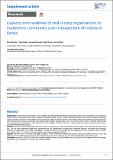| dc.contributor.author | Marita, Enock | |
| dc.contributor.author | Oule, Jared | |
| dc.contributor.author | Mungai, Margaret | |
| dc.contributor.author | Thiam, Sylla | |
| dc.contributor.author | Ilako, Festus | |
| dc.date.accessioned | 2021-08-24T12:57:33Z | |
| dc.date.available | 2021-08-24T12:57:33Z | |
| dc.date.issued | 11/26/2016 | |
| dc.identifier.citation | The Pan African Medical Journal. 2016;25 (Supp 2):6. | en_US |
| dc.identifier.issn | 1937-8688 | |
| dc.identifier.uri | http://repository.amref.org/handle/123456789/129 | |
| dc.description | © Enock Marita et al. The Pan African Medical Journal - ISSN 1937-8688. This is an Open Access article distributed under the terms of the Creative Commons Attribution License (http://creativecommons.org/licenses/by/2.0), which permits unrestricted use, distribution, and reproduction in any medium, provided the original work is
properly cited. | en_US |
| dc.description.abstract | Introduction: Civil Society Organizations (CSOs) contribute to achieving development goals through advocacy, social mobilisation and provision of
health services. CSO programming is a key component of Global Fund (GF) grants; however, CSOs face technical and governance capacity challenges
in grant utilisation leading to missed opportunities for improving health at community level. Amref Health Africa was appointed Principal Recipient of
a GF grant aimed at scaling up community case management of malaria through CSOs as sub-recipients in western Kenya. To identify potential risks
and strengthen grant management, Amref Health Africa and the Ministry of Health conducted a capacity needs assessment to determine the capacity
of CSOs to effectively utilise grants.
Methods: 26 selected CSOs participated in this study. Document reviews and on-site assessments and observations were conducted using structured
tool. The five main assessment areas were: governance and risk management; strategic and operational planning; monitoring and evaluation;
programme management; and financial management. Overall performance was grouped into four categories: 3.0-2.5 (excellent), 2.0-2.4 (good),
1.5-1.9 (fair), and 1.0-1.4 (poor). Data were collected and analysed using Excel software.
Results: twenty five out of 26 CSOs were legally compliant. 14(54%) CSOs were categorized as good; 7(27%) as excellent; 3(12%) as poor and
2(8%) as fair. Most CSOs had good programme management capacity but monitoring and evaluation presented the most capacity gaps.
Conclusion: more than 75% of the CSOs were rated as excellent or good. A capacity building plan, programme risk management plan and oversight
mechanisms were important for successful grant implementation. | en_US |
| dc.description.sponsorship | African Medical Research Foundation | en_US |
| dc.language.iso | en | en_US |
| dc.publisher | Pan African Medical Journal | en_US |
| dc.relation.ispartofseries | Strengthening health systems in communities: the experiences of AMREF Health Africa;Supp. 2: 6 | |
| dc.subject | Capacity assessment | en_US |
| dc.subject | Risk management | en_US |
| dc.subject | Malaria case management | en_US |
| dc.subject | Civil society organisations | en_US |
| dc.subject | Capacity building | en_US |
| dc.subject | Governance | en_US |
| dc.title | Capacity and Readiness of Civil Society Organisations to Implement Community Case Management of Malaria in Kenya | en_US |
| dc.type | Article, Journal | en_US |

